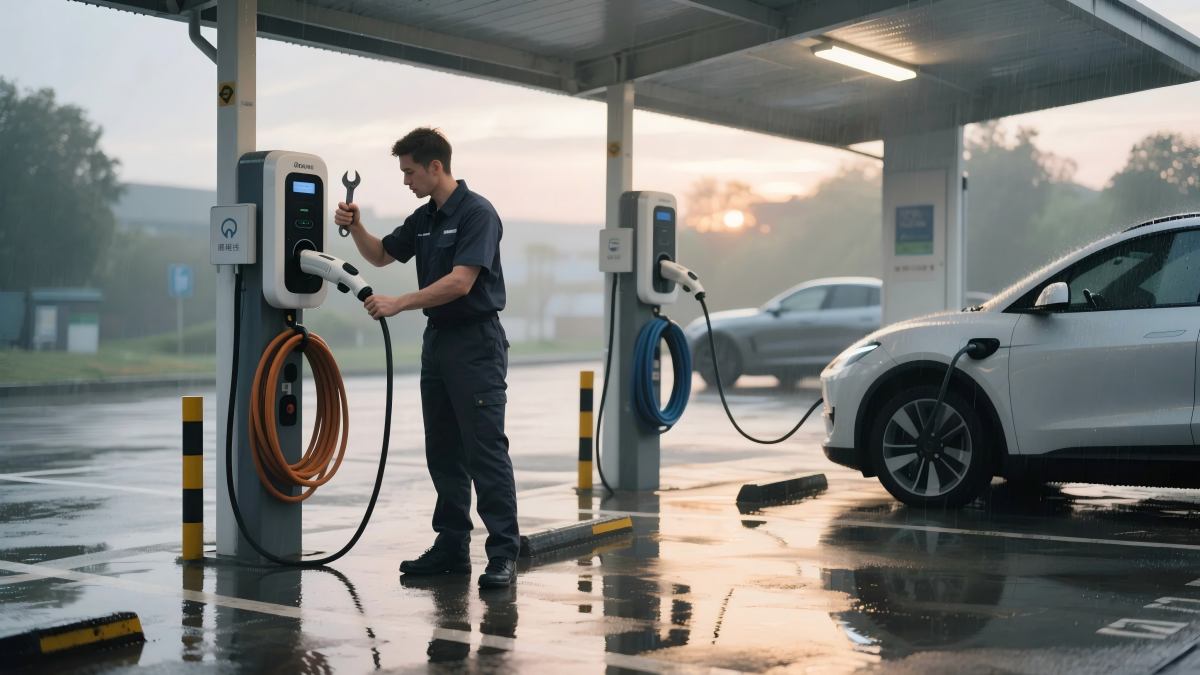 The Role of ISO 15118 in EV Connector Communication (2025)
The Role of ISO 15118 in EV Connector Communication (2025)
Sep 11, 2025
You plug in, the screen wakes, and energy starts to move. In those first seconds the vehicle and the charger agree on identity, limits, and safety. ISO 15118 provides the shared protocol that lets the car and charger agree on the terms of a session. It sits above the metal and seals inside the connector, turning a mechanical mate into a predictable digital exchange.
What ISO 15118 actually doesISO 15118 defines the messages and timings an EV and a charging system use during a session. It covers capability discovery, contract-based authentication, pricing and schedule updates, and how both sides should respond to faults. With a shared protocol, a car can authenticate at the cable, a site can shape power in real time, and logs can be tied to vehicles rather than swipe cards.
How data rides through a physical connectorThe same assembly that carries hundreds of amps also carries a narrowband data signal. In most public DC systems outside China, that signal rides on the power conductors while dedicated pins confirm presence and allow high-voltage contactors to close. Stable contact resistance, shield continuity, and clean ground paths keep the channel intact. When any of those slip, the station shows a “communication” fault even though the root cause is mechanical or environmental.
Plug & Charge—what changes at the startPlug & Charge uses certificates so the vehicle can present its contract at the moment of insertion. The charger checks that contract and starts the session without cards or apps. Sites see shorter queues and fewer support calls. Fleet operators get charging records mapped to vehicle asset IDs, making cost allocation and audits straightforward.
Smart power, scheduling, and bidirectional readinessBeyond a basic current cap, ISO 15118 supports negotiated power ceilings, scheduling windows, and contingency rules when conditions change. Depots can smooth peaks and schedule topping sessions across a shift. Highway sites can share limited capacity across many bays with predictable ramps instead of abrupt cuts. The same building blocks prepare hardware and software for wider vehicle-to-grid use as markets mature.
From plug-in to power-on: how a charging session unfolds
Handle seats and locks; proximity and presence circuits confirm a safe mate.
A communication link forms; roles are set and capabilities exchanged.
Identity is presented; if enabled, a contract is verified at the cable.
Limits are agreed: voltage window, current ceiling, ramp profile, thermal plan.
The charger aligns bus voltage and closes contactors under supervision.
Current ramps to the profile while both sides monitor and adjust.
The session stops; current ramps down, contactors open, and a receipt is recorded.
Buyer and operator scorecard
Dimension
What it looks like on site
Why it matters
What to ask vendors for
Handshake reliability
First-try starts during peak hours
Fewer queues and retries
Success rates by temperature and humidity bands
Time to first kWh
Seconds from plug-in to energy
Real throughput, not just nameplate power
Distribution data and acceptance targets
Plug & Charge readiness
Contract at the cable, no cards or apps
Shorter lines, cleaner logs
Certificate lifecycle tooling and renewal process
Thermal derating clarity
Predictable current steps as heat rises
Driver trust and reliable ETAs
Pin-temperature sensing and on-screen messaging behavior
EMC discipline
Stable comms next to high current
Fewer “phantom” protocol faults
Shielding/ground design and continuity test results
Serviceability
Minutes-level swaps for handles and cables
Lower downtime and callout costs
MTTR targets, labeled parts, video procedures
Lifecycle documentation
Limits, inspection cadence, failure modes in simple terms
Safer, repeatable operations across shifts
Maintenance schedule and acceptance tests
Engineering notesTreat shielding and ground as first-class design elements. Verify shield continuity across the full assembly and route drains with low-impedance terminations. Place temperature sensors close to the hottest elements so current steps are smooth rather than abrupt. As a practical reference point, some high-current DC handles—such as Workersbee high-current DC handle—embed sensing near hot spots and maintain continuous shield paths from handle to cabinet. These choices reduce “mystery” faults in busy windows.
Field observationsMost handshake retries show up on chilly mornings, with damp connectors, and during hot, sun-soaked afternoons. Condensation inside cavities and loose ground lugs inject noise into the data channel. Balancing sealing and venting, adding a quick torque check to the inspection routine, and routing cables to avoid sharp bends cut retries sharply. Assemblies with verified shield continuity and grounding—e.g., Workersbee ISO 15118-ready connector assemblies—help keep the data path quiet when current and heat are high.
Implementation details you can verify• Every build lot should include checks for shield continuity and ground resistance, plus a temperature-rise spot test at representative currents.
• On site, measure two timing metrics separately: plug-in to pre-charge, and pre-charge to first amp. If either drifts, inspect mechanics before software.
• Track aborted starts per hundred plugs by bay and by cable age; patterns often reveal a specific run or routing issue.
Service playbook excerptWhen a “communication error” appears, work the order: visual inspection → ground continuity → shield continuity → temperature-sensor sanity check → trial session. Replace parts in the sequence handle → cable → terminal assembly to minimize downtime. Aim for minutes-level recovery. Keep a labeled spare kit and a short video procedure at each site.
Why connector and cable choices decide protocol stabilityA connector that stays dry internally, holds its torque, and keeps low contact resistance protects the data channel that rides on the power lines. Good ergonomics reduce twisting and side loads that loosen lugs over time. Clear labeling and minutes-level swaps turn a site incident into a short pause instead of a lane closure. This is where specification sheets meet operations: signal integrity and thermal behavior live or die inside the handle and along the cable, not just in the cabinet.
Driver tips that reduce errors• Insert with the handle aligned; avoid twisting under load.• If a fault appears, reseat once, then try a neighboring bay.• After rain or washing, wipe the inlet face to clear moisture films that can couple noise into the channel.• Watch for on-screen notes about planned current steps; a gentle ramp usually signals thermal management, not a failure.
Key takeaways for fleets and site ownersMake ISO 15118 a requirement in RFQs and acceptance tests. Measure more than uptime by tracking handshake success, time to first kWh, and recovery after a reseat. Standardize spares and labels so field teams replace the right part on the first visit. Keep certificate updates on a schedule and hold grounding continuity to the same standard you apply to thermal limits. Do these well and sessions start clean, climb predictably, and stay stable during rush hours.
Read More

 How to Upgrade Existing Chargers to Support New Connectors
How to Upgrade Existing Chargers to Support New Connectors
 The Role of ISO 15118 in EV Connector Communication (2025)
The Role of ISO 15118 in EV Connector Communication (2025)